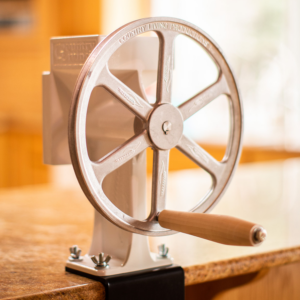History Of The Grain Mill
A bad experience with an electric grain grinder started me on an education process that has lasted well over a decade, and is still going on.
A few of the things I've learned about grinding plates for grain mills:
 1) An internationally respected research institute dedicated to upgrading food production and resources for third world countries extensively researched the effectiveness and viability of grain mills with both stone plates and those with iron and steel. Their recommendation, without reservations, iron or steel over stone! Why? Primarily because of the grit and particulates left behind by some grinding plates. I saw numerous pictures of skulls, both old world and new world, with the teeth worn completely away. Researchers say the total destruction of the teeth was the result of eating stone ground grains.
1) An internationally respected research institute dedicated to upgrading food production and resources for third world countries extensively researched the effectiveness and viability of grain mills with both stone plates and those with iron and steel. Their recommendation, without reservations, iron or steel over stone! Why? Primarily because of the grit and particulates left behind by some grinding plates. I saw numerous pictures of skulls, both old world and new world, with the teeth worn completely away. Researchers say the total destruction of the teeth was the result of eating stone ground grains.
2) A variety of stones have been used as grinding surfaces for grain and food mills - often whatever stone has been available has been the "stone of choice". I have even seen sandstone grinding plates. Unfortunately, for the millions of molars that have masticated stone-ground flour over the centuries, particulates break away from the grinding surface quite easily. Also, Mother Nature is not always consistent in the stone-making department and she doesn't discriminate against such things as lead and arsenic seeping through the ground water or existing in the stone itself.
3) My next step in searching for the perfect grain-grinding surface led me to a major manufacturer of stone grinding wheels. “What are man made stones manufactured from?” I asked. “Aluminum oxide plus binders,” was the answer.
Aluminum has long been linked to a woeful list of ailments - dreaded Alzheimer's is the latest. Ingesting aluminum in powdered form in your bread and pancakes is about as smart as eating slug bait for breakfast. Yet I and thousands of others have done just that because of the misinformation that's rife in grain grinding lore.
4) The coolness of the grind is often dependent on at least two factors:
- How efficiently the grinding surface works
- The speed of the mill
- A superior design means a cooler grind
The Quest for Superior Grinding Plates
Fine - Tough - Long Lasting - High-Carbon Steel: Country Living Grinding Plates.
When I started manufacturing the Country Living Grain Mill we used a cast iron plate made from sand castings. They worked, but there was not enough control over every aspect of the grinding plate. So recently we decided to spend thousands of dollars more on an injection die that would allow us to create individual wax patterns for each set of plates. For many centuries artisans of fine (and very expensive) sculptings have used this "Lost Wax" process for reproducing their masterpieces.
This state of the art "investment" casting method is so accurate that it could reproduce even a fingerprint if necessary. So, just like the great sculptors who have captured their timeless and priceless creations in metal over the centuries, each set of Country Living high-carbon steel grinding plates is formed using a refined version of the ancient time-proven lost wax process.
Each plate has its own wax model which is coated with a colloidal silica slurry. Then, it's put into an autoclave (an oven using both heat and pressure). This, of course, melts the wax (Lost Wax) leaving only the shell. This shell, because of the heat and pressure, turns into an extraordinarily tough monolithic structure.
Finally, 3,000 degree molten high-carbon steel is poured into the shells. Once cooled and hardened, the plates must be machined to assure complete flatness. No other grinding plates in the world go through more exhaustive processes than the plates for your Country Living Mill.
Jack Jenkins
Country Living Productions


